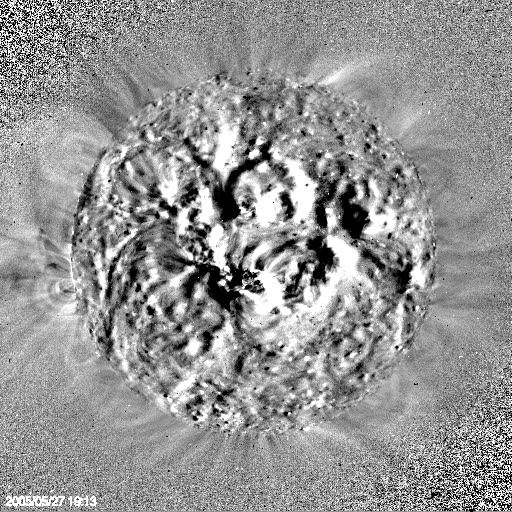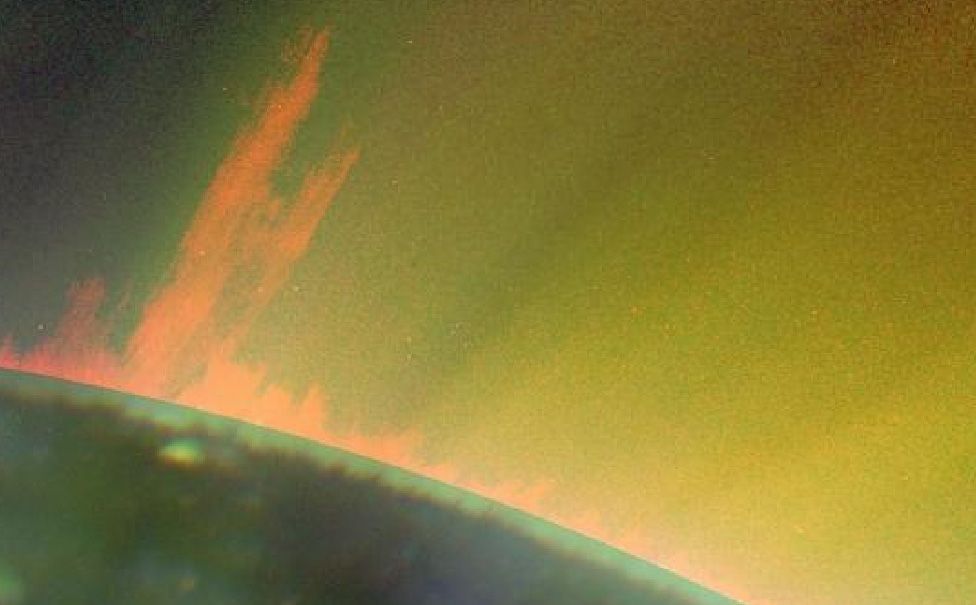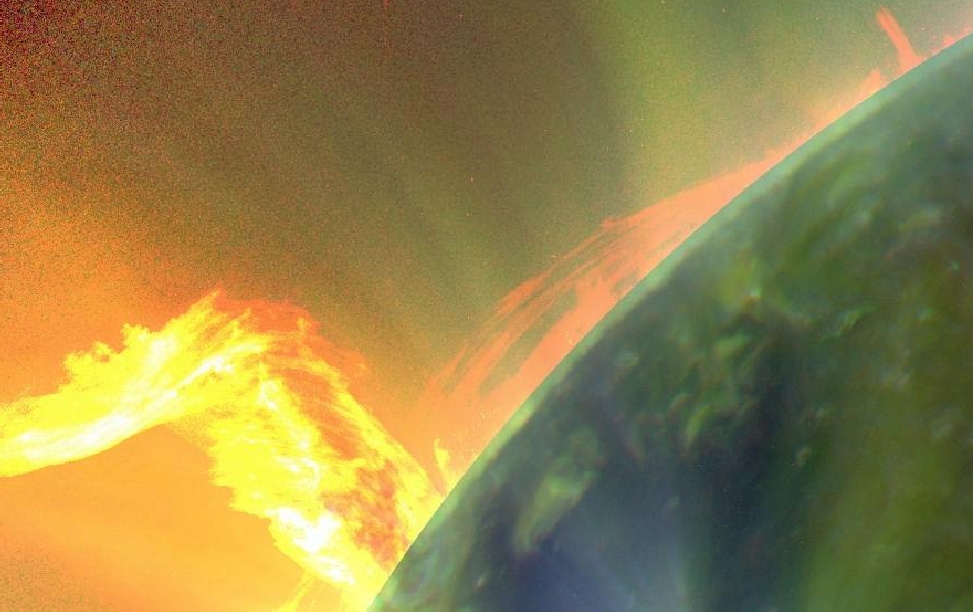dasmiller
Just the right amount of cowbell
Thanks Hellbound, but I am the baby amongst giants.
FWIW, I'm just an engineer. I can do basic thermodynamics, a little structural analysis, etc, but I have to sit on the sidelines for any serious physics.
Thanks Hellbound, but I am the baby amongst giants.
I have staked out a tiny little 7-8 pixel sliver *inside* the surface of your supposedly "opaque" photosphere.
The photoinization aspects of standard theory alone *INSIST* that not a single photons can come from inside the photosphere at these energy states. This is a complete "no brainer" based on standard solar theory. You can't lose.
AUGH. Do you have a probe "7 pixels inside" the photosphere? No you don't, you have a 2D photo where one line of sight passes 7 pixels centerwards of the photosphere. This line of sight passes through the corona AND the chromosphere AND the photosphere at a very steep angle. The only data you have is the integrated light from this line of sight, starting at the top and going down until it's opaque.
We've been repeating this for 10 pages now and you're deaf, deaf, deaf to it.
Just type "2D" for me, Michael. It's not hard. The "2" is a symbol near the top left of your keyboard, the "d" is left of center. Do you have any grasp of this at all?

If we take an RD image based on standard theory that disk *MUST* be larger than the bottom of that red/orange chromosphere.
AUGH. Do you have a probe "7 pixels inside" the photosphere? No you don't,
You're wrong, Michael.
To be completely honest, you're making yourself look very bad by repeating this over and over and over while pretending no one has corrected you on it.
It's really kind of childish.

To which Clinger answered:Mozina said:I just want to know what you think the circumference of the RD sphere will be.
To which you responded:Clinger said:A little more than three times its diameter.
And also:Mozina said:Ok, that is *finally* a quantified prediction and we can clearly tell the difference between standard theory and a Birkeland model. I appreciate you efforts Mr. Spock. You're redeemed.
Mozina said:Actually his answer does seem to set minimum and maximum parameters and that seems to be a start.
You keep harping on it being 2D, but along the limbs we can see a 3D set of features. You can't ignore *THE* most important data!
Well, in SDO images, yes. I can clearly see the red boundary of the chromosphere at the limb. At the limbs we have the opportunity to see under that point provided that it is possible to see under that point.
I count 4800Km under that point before the limb becomes "opaque" (GM definition) in the SDO images.
Speaking of falsifiable predictions, is our wager based on W.D. Clinger's prediction still on?
Just to refresh your memory, you asked:
To which Clinger answered:
To which you responded:
And also:
So, if Clinger's prediction is falsified by the RD image, I will publicly eat crow here, as we agreed. What will you do if his prediction is correct?
2D! He said 2D! One point for effort.
How did "talking about the limb data" become "ignoring the limb data"? The limb is exactly where the 3D-to-2D projection is the most complicated; it's where otherwise-thin features become thick, otherwise-dim features become bright, otherwise-transparent features become opaque.

Any "running difference" disk that shows up in RD image will tell the whole story. If the mainstream is right, the then if we put a running difference movie in relationship to that red ring, the disk can necessary be no smaller than the first pixel of the red. If the RD edge doesn't reach the red, Birkeland's model is correct, and their model is forever falsified. There just are no two ways about it. I'm confident that when we put together a RD movie at 171A and place it in relationship to the chromosphere, the disk will consitently rotate inside the chromosphere with 4800 around the disk.
It's not "complicated" and it's not "opaque" at all.
[qimg]http://www.thesurfaceofthesun.com/images/sdo/sd02.jpg[/qimg]
The "opaque" area is 4800Km under the chromosphere and the area you claim is "opaque" isn't.
Certainly.
Will everyone agree to at least the minimum and maximum as it relates to the RD radius? There still seems to be some debate yet.
Any "running difference" disk that shows up in RD image will tell the whole story. If the mainstream is right, the then if we put a running difference movie in relationship to that red ring, the disk can necessary be no smaller than the first pixel of the red. If the RD edge doesn't reach the red, Birkeland's model is correct, and their model is forever falsified.
Even if you weren't completely wrong about the standard model and you could some how falsify it this would not make your model correct. In fact the fact that the standard model had been falsified would provide precisely zero evidence in favour of your model.
Hard to get off square one, isn't it? Michael, please answer yes or no.
You think that the red stuff is the corona?
You think that the green stuff is "transparent neon"?
You think that the black stuff is iron?
Your model violates the laws of thermodynamics. Of course its wrong.What other solar model predicted these images Tubbythin? That limb darkening happens *exactly* where Kosovichev's data suggested. It's right on, including the best error bars I could come up with for both technologies. It can't be wrong now. It's been confirmed by two different technologies.
Well you're still failing miserably with basic geometry.You guys are now coming into my "hood". I cut my teeth on solar image analysis and SDO is what I've waited my whole life for. There is no way you guys will ever compete now. You're in my territory with SDO images, and I'm not ashamed to count pixels.

It has already been determined that the solar disk radius at 171A (transition region - chromosphere) is roughly 10 arcseconds larger than the optical (photospheric) radius. At a distance of 1 AU that angular measure translates into 7253 km, assuming I have done the conversion correctly. So there is in fact nothing to debate. It has all been done already and the Mozina model is the loser, as one would naturally expect.
You never said anything, that's the first explanation I've been able to squeeze out of you.No, chromosphere. If I said corona, my bad.
It's probably mostly transparent silicon with a thin layer of transparent neon.
Yes.
That means that no iron ion light should be seen in below that point.
[qimg]http://www.thesurfaceofthesun.com/images/sdo/sd03.jpg[/qimg]
Here's a third side of the same image. All along the underside of the red area, it's supposed to be "opaque" (GM style) to these wavelengths in 3.5 meters, not kilometers, meters. That means that no iron ion light should be seen in below that point. All along the limbs however we see a light green area. Below that it becomes "opaque" (GM definition) at about 4800Km under the chromosphere.
I have tried and tried and tried to get a useful measurement out of SOHO and STEREO that was definitive, but the resolution was simply not good enough IMO. In SDO however PS, there's no way to miss the problem.
According to this model, the solid surface is located at about 4800 KM under the base of the chromosphere.
What's in between the "base of the chromosphere" and the solid surface, Michael?
Highly ionized silicon and neon plasma.
And what emits visible sunlight? You know, that stuff that makes it light out during the day?
The neon layer and oxygen and other ionized elements inside that neon. If I could figure out what absorbs 94A, I might figure out what "cools off" and then is re excited, and that might allow me go give you a temperature range of something. Without that bit of info however, I'm clueless how to give you surface temperatures at the surface of the photosphere so I'll stick with the standard model for the time being.
It has already been determined that the solar disk radius at 171A (transition region - chromosphere) is roughly 10 arcseconds larger than the optical (photospheric) radius. At a distance of 1 AU that angular measure translates into 7253 km, assuming I have done the conversion correctly. So there is in fact nothing to debate. It has all been done already and the Mozina model is the loser, as one would naturally expect.
Am I going to bet with you? Not a chance. Your "analysis" of the SDO images up to this point has been exceptionally stupid. I predict that it will continue to be equally stupid in the future. Just as you wildly misinterpret the SDO images today, so will you wildly misinterpret the SDO images in the future. You will see some fuzzy color somewhere in some image, wildly misinterpret it, and declare yourself the winner and the standard theory dead (as you have in fact done already several times with an equivalent level of stupidity). Since we know in advance that you will claim to have "won" the bet, quite regardless of what is actually in the images, why would anyone bother to bet with you?So naturally I should come out the "looser" in SDO too, right? Higher resolution allows us to check that result, correct? Care to ante up your public change of opinion if it doesn't work out that way in SDO RD images?
94 Angstroms is Fe XVIII (Fe +17).
I missed this the first time around. Geez, Mozina needs the neon/silicon unobtanium to be transparent to 94A? Last time he was just trying to get it transparent to 171A. Neon ions up to Ne VI will absorb 94A light. Michael's handpicked plasma---previously imagined to be strictly confined to Ne IV, V, VI, and VII if I recall correctly---must now be reimagined as being VII, VIII, IX, X, and X only. Toss in a similar shift for the recently-added silicon and the rarely-mentioned calcium (it was in his diagram). What are we on now? Mozplasma 3.1? Mozplasma NT? Who cares---Mozina sure doesn't seem to. One violates just as many laws of physics as the other.
A whole warren of math bunnies,that is too much for Michael to cope with.He does not concern himself with such mundane things a maths and formulas.94 Angstroms is Fe XVIII (Fe +17). It's one of the lines observed by the AIA instrument on SDO (download the SDO system overview PDF and you will find it there). It probes a temperature of 106.8 (that's 6,310,000) Kelvins, according to the AIA system overview document. The energy of a 94A photon is just Planck's constant * speed of light /wavelength (hc/l) and that's 131.9 eV. if I just express that energy in temperature units (Energy = Boltzmann's constant * temperature or E = kT) I get 1,530,000 Kelvins. So it's clear that if you want that Fe XVIII to "cool off and the re-excite" you need an environment in excess of 1,000,000 Kelvins to pull it off, either in radiation temperature or in electron temperature, take your pick.
The ionization enthalpy for Fe +17 is 122,200 kilo Joules (1.222x108 J) per mole (kJ/mol; Webelements Iron). One mole of iron, in isotopic abundance as found on Earth, weighs in at 55.847 grams. Let's just do a quick estimate and multiply the surface area of the sun (6.087x1022 cm2; Allen's Astrophysical Quantities, 4th edition 2000) by 1 km (105 cm) and assume a layer of Fe XVIII one kilometer thick. I will use the same mass density I gave Sol Invictus, 10-7 gm/cm3. So do the "math" (arithmetic really) and you get 6.087x1020 gm of Fe XVIII, if we follow the usual Mozina recipe and assume that all of the iron is ionized to the highest state. That's 1.09x1019 moles, which requires 1.33x1027 Joules of energy to ionize to the desired state.
The total luminosity of the sun is 3.845x1026[/sup ]Watts, where 1 Watt = 1 Joule/second. So the total energy required to ionize all of the iron in a layer of pure iron 1 km thick, at the "surface" of the sun, to Fe XVIII is about a factor of 3.4 greater than the total radiant energy coming from the sun in 1 second. But of course, it's not just a matter of "ionize the iron and we're done". Remember ... cool off and then is re-excited ... We don't just have to ionize the iron to Fe XVIII, we then have to keep it there. And that is going to require, every single second, at least 3.4 times the total energy emitted by the sun as radiant energy. That's just the iron, and that's just a 1 km layer. Make that a 100 km layer and you need 100 times the energy. So as you can see, we have quite an energy budget to balance out here. All that energy has to come from somewhere. It does not make any physical sense to me.
Any "running difference" disk that shows up in RD image will tell the whole story.
Because Mozina is an idiot? Because the gathered throng wants to humor him? My post on the topic has already fallen to the previous page, but allow to to quote myself in full from last night ...
Note that the EIT instrument on SoHO is used to measure the solar disk radius at Mozina's favorite wavelength, 171A, and the number is 969''.54 ± 0''.02. Now see this ...
On the Constancy of the Solar Diameter II; Kuhn, et al., The Astrophysical Journal 613(2): 1241-1252, October 2004
Abstract: The Michelson Doppler Imager instrument on board SOHO has operated for most of a solar cycle. Here we present a careful analysis of solar astrometric data obtained with it from above the Earth's turbulent atmosphere. These data yield the most accurate direct constraint on possible solar radius variations on timescales from minutes to years and the first accurate determination of the solar radius obtained in the absence of atmospheric seeing.
Download the PDF and look at table I, a list of solar disk radius measurements spanning 1979 - 2004. They are all between 960''.52 and 958''.54. And see the last page of the paper, where the authors determine a SoHO MDI radius 959''.28 (all are normalized to a standard distance of 1 AU).
What Mozina wants to do has already been done, and with far greater accuracy & precision that his RD diddling could ever hope to achieve. It has already been determined that the solar disk radius at 171A (transition region - chromosphere) is roughly 10 arcseconds larger than the optical (photospheric) radius. At a distance of 1 AU that angular measure translates into 7253 km, assuming I have done the conversion correctly. So there is in fact nothing to debate. It has all been done already and the Mozina model is the loser, as one would naturally expect.
The MDI instrument images the photosphere in the 6767.8 Angstrom Ni I (that's neutral, non-ionized Nickel) absorption line. That's slightly redder than the eyeball center wavelength of about 5500 Angstroms, in the rough eyeball range 4000 - 7000 Angstroms (with much variation between individual eyes). So there is no doubt that it is sensitive to the eyeball photosphere "surface", where the effective temperature is around 5800 Kelvins.
Here's a third side of the same image. All along the underside of the red area, it's supposed to be "opaque" (GM style) to these wavelengths in 3.5 meters, not kilometers, meters. That means that no iron ion light should be seen in below that point. All along the limbs however we see a light green area. Below that it becomes "opaque" (GM definition) at about 4800Km under the chromosphere.
So naturally I should come out the "looser" in SDO too, right?
Wait a minute sol. How can the rotating disk end up being smaller in diameter than the photosphere?
Those "rigid features" rotate and we can watch them rotate as you're welcome to do with the movies on my website. If those "features" are located in the chromosphere, then any limb image should demonstrate similar features at a distance greater than the photosphere. If you disagree, please explain.
You never said anything, that's the first explanation I've been able to squeeze out of you.
Right. Yikes. Why, then, is this ultrapure transparent neon emitting iron wavelengths? That's the only way a super-thick "transparent" layer would look green like that. It's not like it could be letting light through from behind---behind it, in this projection, is empty space (and the far-side chromosphere/corona).
Yes or no: in this projection, if the "green" is a 4800km thick flat layer, then you're looking diagonally through 80,000 km of it to see the black edge---160,000 km for the pixels looking past the black edge.
Too bad it's not emitting the iron emission lines, eh? That's what "black" means in a photo, MM---it doesn't mean "opaque", it means "not emitting light".
A running difference "disk" (you put the wrong word between quotes) will *ONLY* show you what has *CHANGED* between the two images. How on Earth (or Sol in this case) can that "tell the whole story?"
